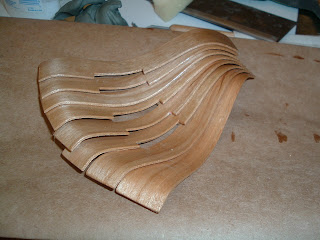
1. Design a wooden toy inspired by Leonardo Da Vinci.
2. Make a model of your toy.
Visual Reference Board: Bellow Prototypes:
Bellow Prototypes:
I found this site useful in coming up with my method for building the bellows.
Here are my first bellow prototypes. For these ones I used an x-acto to cut out the trapezoids from poster board and masking tape and fishing line to connect them together.
Cutting fabric to cover the bellows:
 Here is a video showing the bellow action. I was kind of disappointed because the bellows ended up stretching less and less with each layer of fabric.
Here is a video showing the bellow action. I was kind of disappointed because the bellows ended up stretching less and less with each layer of fabric. Chipboard mockup of body:
Chipboard mockup of body: Two bellows done:
Two bellows done: I cut a bunch of plywood to the profile of my keyboard and glued them together to make a mold:
I cut a bunch of plywood to the profile of my keyboard and glued them together to make a mold: Then I laminated 3 pieces of thin veneer together and stuck them in the the vacuum bag on top of my mold. I will use this to cut out my keys.
Then I laminated 3 pieces of thin veneer together and stuck them in the the vacuum bag on top of my mold. I will use this to cut out my keys. The wood for my keyboard didn't quite take the full contour of the mold so I had to adjusted the end piece of the keyboard casing to match the new key profile.
The wood for my keyboard didn't quite take the full contour of the mold so I had to adjusted the end piece of the keyboard casing to match the new key profile. Here I've put together the keyboard and bass button casings and I have the bellows and unfinished keyboard resting in place. The edges of the casing are burnt because I cut out the wood on the laser cutter. On the keyboard I've masked off where I need to cut the wholes for the black keys. I've also got my unfinished sound ports resting on top.
Here I've put together the keyboard and bass button casings and I have the bellows and unfinished keyboard resting in place. The edges of the casing are burnt because I cut out the wood on the laser cutter. On the keyboard I've masked off where I need to cut the wholes for the black keys. I've also got my unfinished sound ports resting on top. I sanded off the burned edges and gave the casings a rich bombay mahogany stain. I finished it off with two coats of high gloss polyurithane.
I sanded off the burned edges and gave the casings a rich bombay mahogany stain. I finished it off with two coats of high gloss polyurithane. The white keys stay their natural color and only need 2 coats of high gloss polyurithane finish.
The white keys stay their natural color and only need 2 coats of high gloss polyurithane finish. I modeled the sound ports out of a non-hardening wax-based modeling clay called plastaline. Then I spray painted them gold.
I modeled the sound ports out of a non-hardening wax-based modeling clay called plastaline. Then I spray painted them gold. This photo depicts a cross section of the keyboard action. I used fabric for the hinge and red foam to spring the depressed keys back. The dark keys are stationary for this model.
This photo depicts a cross section of the keyboard action. I used fabric for the hinge and red foam to spring the depressed keys back. The dark keys are stationary for this model.

















